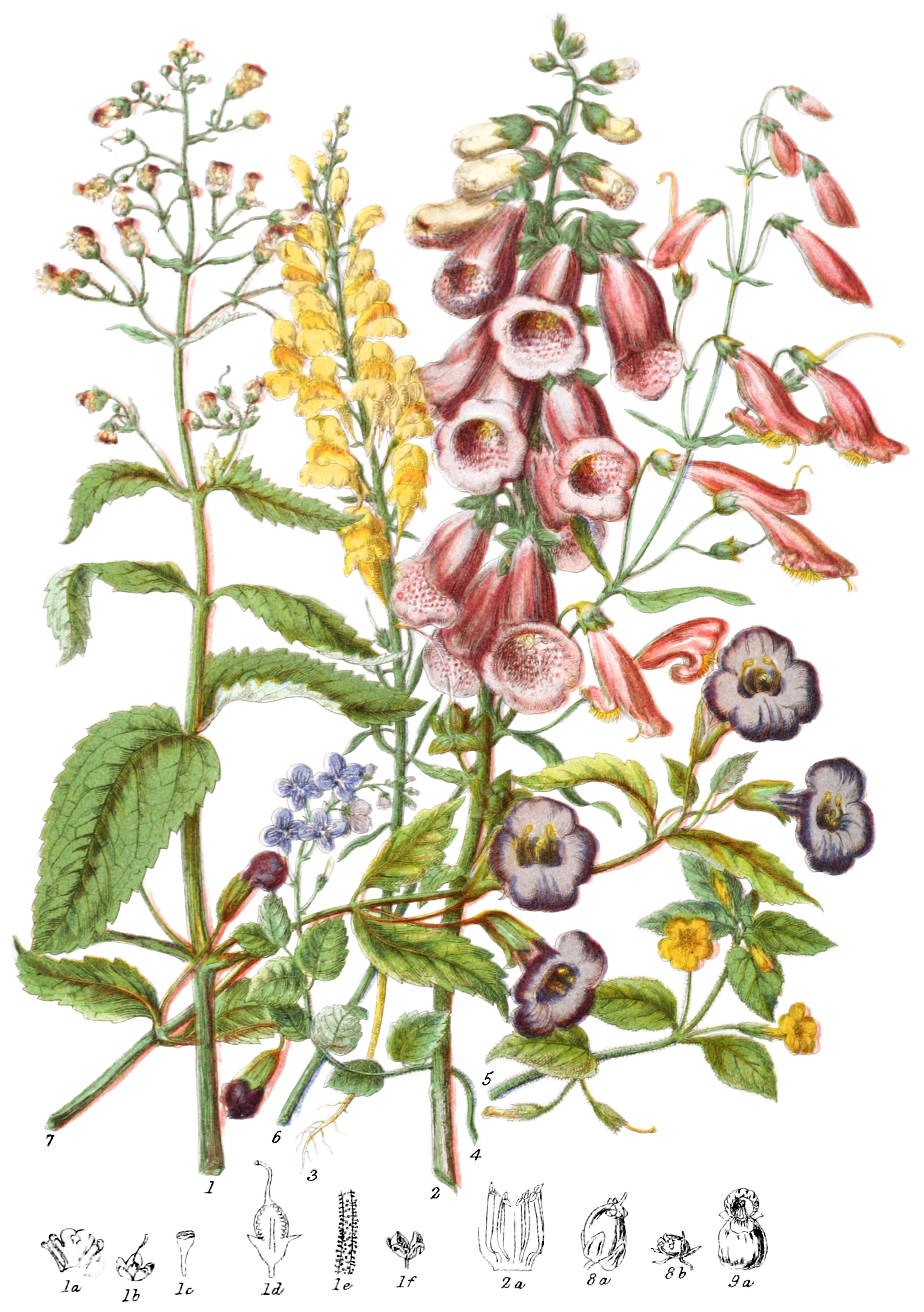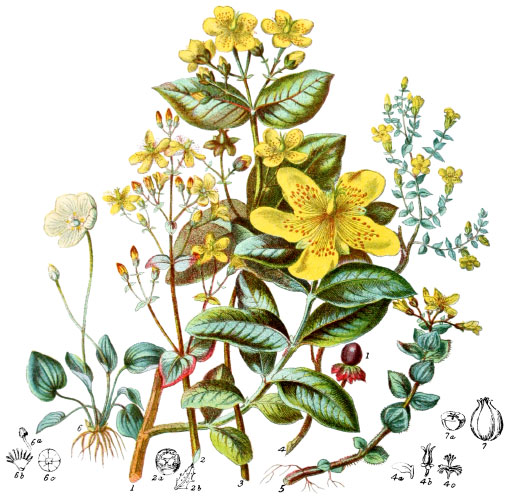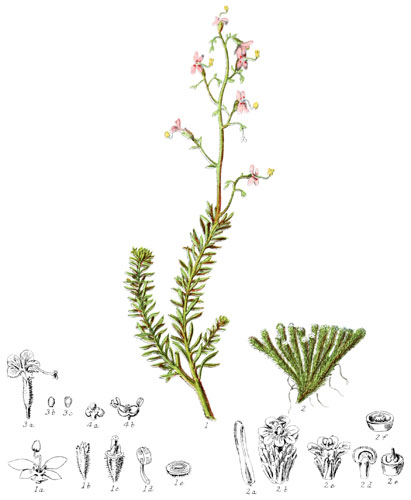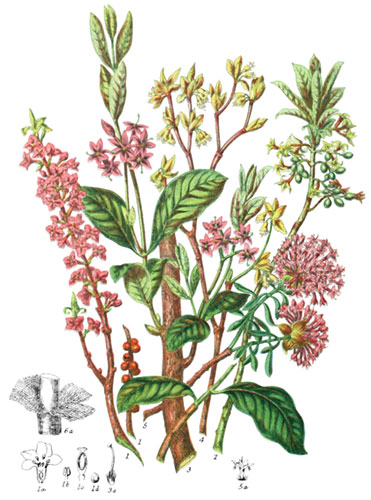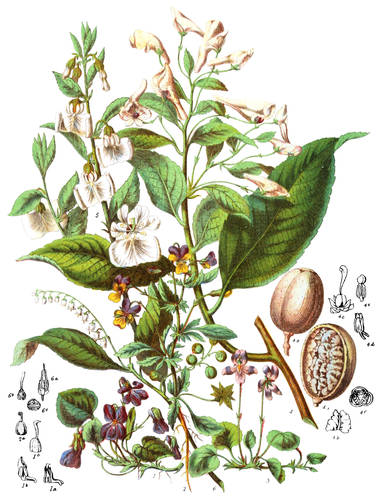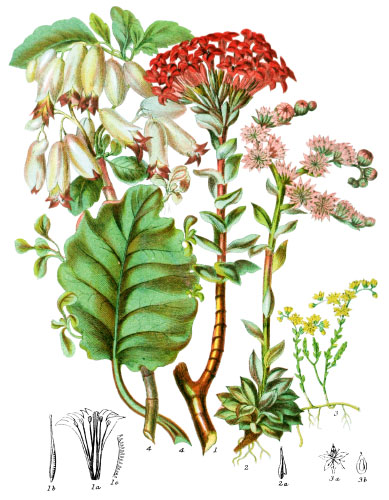Key characteristics
Shrubs and herbaceous plants. The leaves are opposite, alternate, or whorled. The flowers are on branching stalks, or grow from the base of the leaf-stalk; seldom in spikes. The flower-stalks are opposite or alternate, simple and one-flowered, or many-flowered on dichotomous branches. The calyx is below the ovary, persistent, four or five-lobed; the sepals more or less divided, sometimes quite distinct, often unequal, the side ones smaller. The corolla is of one petal, five-parted, or the two upper petals united at their points, making it four-parted; the tube is long or short; the upper part of the corolla flat, as in Veronica, or erect, nearly equally divided, or two-lipped, sometimes spurred at the base, folded over in the bud, the upper lobe innermost. The stamens are in a single row opposite the sepals, the upper one wanting or imperfect, the two lower often deficient; the anthers are two-celled, opening lengthwise. The ovary is two-celled, the style simple or rarely bifid. The fruit is a capsule, seldom a berry, two-celled sometimes opening by pores or lids. The seeds are small, numerous, and contain albumen.
This Tribe has most affinity with Solanaceæ, but the corolla differs in not being plaited. Buchnera being leafless, and Striga parasitic, they form a link with Orobanchaceæ.
Acrid and bitter properties prevail in the leaves and roots of several species.
Select plants in this order
Not all plants listed are illustrated and not all plants illustrated are listed.
- Scrophularia, Fig-wort, is dispersed over Europe, and extends to the Canaries, north of Africa, and the Levant.
- S. aquatica (1) is frequent in ditches, and is remarkable for the acute angles of the stem, and the small dark flowers. It has an unpleasant scent, and scarcely any animals will eat it. It is said, however, that the roots are wholesome, and that they afforded food to the starving garrison at the siege of Rochelle.
- S. divaricata, of the Altai mountains, has extremely large leaves.
- Digitalis was so named by Fuchs, from the flower being shaped like a thimble.
- D. purpurea (2) is one of the most ornamental of our native plants, and is admitted to gardens and shrubberies: although a strong poison, it affords a valuable medicine in the dried leaves.
- Several species are natives of Europe; D. ambigua and others with yellow blossoms are amongst the beautiful flowers that adorn the Alps of Switzerland and Tyrol, delighting the traveller and botanist.
- Linaria is abundant on hedge-banks in many districts; its flowers yield a yellow dye and bitter medicine, but in sandy pastures it becomes a troublesome weed.
- L. cymbalaria grows chiefly on walls, and can endures the smoke of cities; it has a pungent flavour like cress, and is supposed to have medicinal value in India.
- L. pilosa of the Pyrenees has round leaves, densely hairy.
- L. sapphirina is an exceedingly elegant Portuguese species.
- Antirrhinum is of nearly similar appearance, but the flower has no spur, is merely swollen at the base.
- A. majus, seen on some of our old walls, affords many pleasing varieties for gardens. The seed-vessel (8)* opening by three pores, has a strong resemblance to the head of monkey.
- Veronica chamædrys (4), an example of the flat-flowered section of the tribe, is a general favourite, opening its delicate blue flower in spring on banks and in meadows. Before the true Tea was imported, it was used for a common beverage, and is still esteemed good in Sweden.
- All the European species are small herbs, but V. speciosa of New Zealand is a large plant bearing fine spikes of blue flowers; an arborescent kind has been discovered in Lord Auckland’s Isles.
- V. beccabunga and other British species belong also to mountain rivulets in North America.
- Mimulus moschatus (5) is very fragile, but much cultivated for its agreeable scent.
- Torenia (7) is considered medicinal in Malabar.
- Euphrasia, Eyebright, is one of the plants constantly to be found on our chalk downs, occasionally used for its medicinal qualities.
- Melampyrum is a favourite with cows, and is said to cause good butter.
- Rhinanthus, the Yellow-Rattle, usually forms part of the crop in a hay-meadow. Like others of this tribe, the flowers resemble the nose of an animal. Such likenesses have been imagined for several of these flowers.
- Chelone (6) was so named from the Greek for a tortoise, which the the back of the flower was thought to resemble in shape, though not in colour.
- Buddlea globosa is a shrub with honey-scented orange-coloured flowers: B. madagascariensis bears slender spikes of flowers.
- B. Neemda is an elegant Indian species; all have long narrow leaves, silvery beneath.
- Teedia and Manulea come from the Cape.
- Browallia, Schizanthus, and others, have been introduced from Chile and Peru by exploring travellers.
- Paulownia is a tree bearing noble spikes of purple flowers on brown stalks; rarely flowering in this country, forming an obvious link with Bignoniaceæ.
- Maurandya and Lophospermum are climbing plants flowering abundantly.
- Among useful medicinal plants in this tribe is Gratiola officinalis in the meadow pastures of Switzerland, G. peruviana in Peru, Bramia serrata in Brazil, and Vandelia diffusa in Guiana.
- Scoparia dulcis is a remedy for ague in Jamaica.
- Picrorhiza and Herpestes are intensely bitter herbs of India.
- Sibthorpia is a graceful little trailing plant in Cornwall, recording the name of the collector of the classical Flora Græca.
- Limosella aquatica, the humble Mud-wort of ponds, also finds its place in this tribe of varied aspect.
- The corolla of Calceolaria (9)† is extremely enlarged at the base, forming a kind of slipper.
Locations
This Tribe is extensively dispersed over the world, from the Tropics to the coldest regions; in Central Europe it forms about one-twenty sixth of flowering plants; one species is found in Melville Isle, and several contribute to the scanty vegetation of Tierra del Fuego.
Legend
- Scrophularia aquatia, Water Fig-wort. England.
- Flower opened.
- Calyx and Ovary.
- Stamen.
- Section of Ovary.
- Stalk, magnified.
- Capsule and Calyx.
- Digitalis purpurea, Purple Foxglove. England.
- Stamens.
- Linaria vulgaris, Common Toad-flax. England.
- Veronica chamædrys, Germander Speedwell. England.
- Mimulus moschatus, Musk-plant. Colombia.
- Chelone barbata. Mexico.
- Torenia asiatica. East Indies.
-
- Antirrhinum majus. Capsule.
- Capsule of A. orontium.
-
- Flower of Calceolaria.
- *8 was mentioned in the original description but only 8a and 8b were illustrated.
- †9 was mentioned in the original description but only 9a was illustrated.
Explore more
Posters
Decorate your walls with colorful detailed posters based on Elizabeth Twining’s beautiful two-volume set from 1868.
Puzzles
Challenge yourself or someone else to assemble a puzzle of all 160 botanical illustrations.
